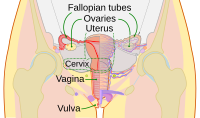
Photo from wikipedia
The aim was to investigate the association of the delivery mode and vertical transmission of severe acute respiratory syndrome coronavirus‐2 (SARS‐CoV‐2) through the samples of vaginal secretions, placenta, cord blood,… Click to show full abstract
The aim was to investigate the association of the delivery mode and vertical transmission of severe acute respiratory syndrome coronavirus‐2 (SARS‐CoV‐2) through the samples of vaginal secretions, placenta, cord blood, or amniotic fluid as well as the neonatal outcomes. This cross‐sectional study presents an analysis of prospectively gathered data collected at a single tertiary hospital. Sixty‐three pregnant women with confirmed coronavirus disease 2019 (COVID‐19) participated in the study. Vertical transmission of SARS‐CoV‐2 was analyzed with reverse transcriptase‐polymerase chain reaction (RT‐PCR) tests and blood tests for immunoglobulin G (IgG)–immunoglobulin M (IgM) antibodies. All patients were in the mild or moderate category for COVID‐19. Only one placental sample and two of the vaginal secretion samples were positive for SARS‐CoV‐2. Except for one, all positive samples were obtained from patients who gave birth by cesarean. All cord blood and amniotic fluid samples were negative for SARS‐CoV‐2. Two newborns were screened positive for COVID‐19 IgG–IgM within 24 h after delivery, but the RT‐PCR tests were negative. A positive RT‐PCR result was detected in a neof a mother whose placenta, cord blood, amniotic fluid, and vaginal secretions samples were negative. He died due to pulmonary hemorrhage on the 11th day of life. In conclusion, we demonstrated that SARS‐CoV‐2 can be detectable in the placenta or vaginal secretions of pregnant women. Detection of the virus in the placenta or vaginal secretions may not be associated with neonatal infection. Vaginal delivery may not increase the incidence of neonatal infection, and cesarean may not prevent vertical transmission. The decision regarding the mode of delivery should be based on obstetric indications and COVID‐19 severity.
Journal Title: Journal of Medical Virology
Year Published: 2021
Link to full text (if available)
Share on Social Media: Sign Up to like & get
recommendations!